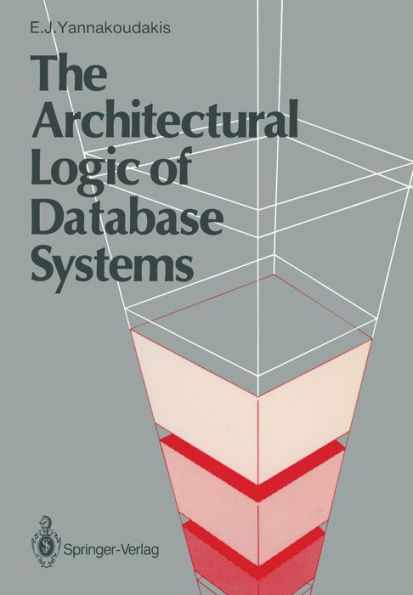5
1

The Architectural Logic of Database Systems
318
by Emmanuel J. Yannakoudakis
Emmanuel J. Yannakoudakis

The Architectural Logic of Database Systems
318
by Emmanuel J. Yannakoudakis
Emmanuel J. Yannakoudakis
Paperback(Softcover reprint of the original 1st ed. 1988)
$54.99
-
PICK UP IN STORECheck Availability at Nearby Stores
Available within 2 business hours
Related collections and offers
54.99
In Stock
Overview
If we look back to pre-database systems and the data units which were in use, we will establish a hierarchy starting with the concept of 'field' used to build 'records' which were in turn used to build higher data units such as 'files'. The file was considered to be the ultimate data unit of information processing and data binding 'monolith'. Moreover, pre database systems were designed with one or more programming languages in mind and this in effect restricted independent development and modelling of the applications and associated storage structures. Database systems came along not to turn the above three units into outmoded concepts, but rather to extend them further by establishing a higher logical unit for data description and thereby offer high level data manipulation functions. It also becomes possible for computer professionals and other users to view all information processing needs of an organisation through an integrated, disciplined and methodical approach. So, database systems employ the concepts field, record and file without necessarily making them transparent to the user who is in effect offered a high level language to define data units and relation ships, and another language to manipulate these. A major objective of database systems is to allow logical manipulations to be carried out independent of storage manipulations and vice versa.

Product Details
| ISBN-13: | 9783540195139 |
|---|---|
| Publisher: | Springer London |
| Publication date: | 06/15/1988 |
| Edition description: | Softcover reprint of the original 1st ed. 1988 |
| Pages: | 318 |
| Product dimensions: | 6.69(w) x 9.61(h) x 0.03(d) |
Table of Contents
1 Foundations of Databases.- 1.1 Data and Information.- 1.2 Program and File Communication.- 1.3 Program and Meta-file Communication.- 1.4 Towards a Database System.- 1.5 High Level Database Software.- 1.6 Summary.- 1.7 References.- 2 The Logic of the Database Environment.- 2.1 The Principle of Data Independence.- 2.2 Standard Software and the Database.- 2.3 Three Architectural Levels.- 2.4 Types of Users.- 2.5 Summary.- 2.6 References.- 3 Data Structures and Data Models.- 3.1 Introduction.- 3.2 Data Structures and Relationships.- 3.3 Hierarchic Data Models.- 3.4 Network Data Models.- 3.5 Relational Data Models.- 3.6 An Example Schema Model.- 3.7 An Example Subschema Model.- 3.8 Summary.- 3.9 References.- 4 The Architecture of Database Software.- 4.1 Introduction.- 4.2. Data Description Language (DDL).- 4.3 Data Manipulation Language (DML).- 4.4 Data Storage Description Language (DSDL).- 4.5 Query Language.- 4.6 Query By Example (QBE).- 4.7 Data Dictionary.- 4.8 An Overview of Software Integration.- 4.9 Summary.- 4.10 References.- 5 Communicating with Databases in Natural Language.- 5.1 Programming Languages.- 5.2 The PROLOG Programming Language.- 5.3 Natural Language System Architecture.- 5.4 Communicating with Databases by Voice.- 5.5 Speech Synthesis.- 5.6 Speech Recognition.- 5.7 An Integrated View of Man-Machine Interfaces.- 5.8 Summary.- 5.9 References.- 6 Database Design Methodology.- 6.1 Introduction.- 6.2 Top-Down and Bottom-Up Design.- 6.3 Major Stages in Database Design.- 6.4 Six Mappings.- 6.5 Decomposition and Normalisation.- 6.6 Relationships between Attributes.- 6.7 Key Attributes.- 6.8 The Five Normal Forms.- 6.9 Summary.- 6.10 References.- 7 Canonical Synthesis for Database Design.- 7.1 Introduction.- 7.2 Element Associations.- 7.3 Readying the Views for Canonical Synthesis.- 7.4 The Canonical Synthesis Algorithm.- 7.5 Further Investigations on Canonical Synthesis.- 7.6 Summary.- 7.7 References.- 8 Relational Architecture.- 8.1 Introduction.- 8.2 Domains and Attributes.- 8.3 Manipulation of Relational Tables.- 8.4 Subschema Definitions.- 8.5 Representing Trees.- 8.6 Representing Networks.- 8.7 Summary.- 8.8 References.- 9 A Network Database Language.- 9.1 Introduction.- 9.2 Logical Relationships and Set Types.- 9.3 Structural Relationships.- 9.4 Network Database Language.- 9.5 Summary.- 9.6 References.- 10 Dictionary of Database Terminology.- 11 Appendix. Example Reports from Canonical Synthesis.- 12 Acronyms.From the B&N Reads Blog
Page 1 of
